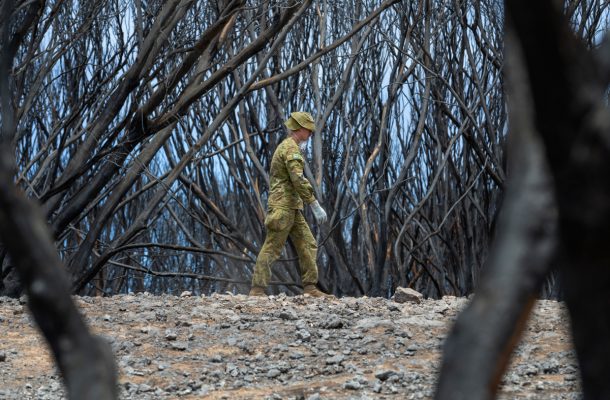The fires demand a strategic response to climate change

In the 1993 cult classic Groundhog Day, Phil Connors (Bill Murray) posed the question: ‘What would you do if you were stuck in one place and every day was exactly the same and nothing you did mattered?’
Depressingly, it must surely sum up the collective outlook of the world’s climate scientists for at least the past two decades. That frustration has been compounded lately by the ‘mixed bag’ of last month’s UN climate talks in Madrid, the continued assault on the scientific method by the administration of US President Donald Trump, and rolling climate-related global environmental catastrophes.
Globally, 2019 was the second hottest year on record. The previous hottest was 2016, followed by 2015, 2017 and 2018. In Australia, 2019 was 1.52°C above the 1961–90 average—the country’s hottest on record. Rainfall across the continent was also the lowest since recordkeeping began.
We have now arrived at a point where, without international action to reduce emissions, global average temperatures will be almost 5°C warmer within the lifetime of a child born today.
The bushfire crisis that’s unfolding across Australia provides some insight into what that dystopian world will look like. So far, 27 people have died, more than 100,000 livestock have been killed, and at least a billion native animals have perished as an area larger than South Korea has been burned.
The Australian Defence Force has been deployed en masse at the behest of the National Security Committee of cabinet. What was meant to be tomorrow’s security problem has been catapulted into the here and now.
Our home front has become the climate front line. Slowly—inexorably—climate change is permeating regional security architectures and its institutions.
Rising emissions will result in a more unstable and insecure world that will have far-reaching human, national and international security consequences. Military forces—as in the current bushfire crisis—will be increasingly called upon to respond.
Limits will be reached and then stretched when multiple climate crisis events occur simultaneously, especially when overlaid with concurrent traditional ‘hard’ security commitments. It will require new thinking about defence force structures, capability and equipment choices, and training regimes.
Building on the 2018 Boe Declaration on Regional Security (and its affirmation in 2019), the region’s defence forces have become more active in their efforts to respond to climate change.
A gathering of South Pacific defence ministers in May acknowledged the Boe Declaration and emphasised the unique and important role of defence forces in dealing with climate change.
Developments at the meeting included a proposal to explore how defence forces can support mitigation efforts. Another was New Zealand’s proposal to hold a defence working group meeting in 2020 focused solely on climate change.
That the New Zealand Defence Force should put its hand up comes as no surprise. It has arguably emerged as one of the world’s leading militaries when it comes to developing a clear strategic response to the climate emergency and promoting global recognition of climate change as a security risk.
Building on its November 2018 defence assessment, The climate crisis: defence readiness and responsibilities, in December 2019, the New Zealand government released an implementation plan titled Responding to the climate crisis. The plan puts the meat on the bone of the NZDF climate response, under four pillars: respond, adapt, mitigate and engage.
While some of the initiatives are business as usual, and some are new, it is the first time the totality of NZDF measures have been presented as a single, coordinated defence response to the threats of climate change. Few militaries have done this.
Initiatives outlined in the plan include developing climate risk assessments and adaptation plans for bases and training areas, embedding climate change considerations into planning for the defence estate and infrastructure and harnessing the Defence Technology Agency to analyse and better understand the operating environment of the Southern Ocean and Ross Sea.
The also include acquiring dual-use and multirole military capabilities in support of increased climate-related humanitarian and disaster relief operations, and placing an increased focus on emissions accounting, emissions reduction and energy efficiency.
As the plan notes, it is something of a first cut and the beginning of what will be a long and iterative journey that seeks to ‘grow best practice and raise our ambition over time’. In pursuit of best practice, they would do well to consider the ‘responsibility to prepare and prevent’, a climate security governance framework developed by the Center for Climate and Security and presented at the UN Security Council.
Importantly, the NZDF is also emboldened to take a regional and international lead on embedding and discussing climate security at the highest political-military levels and security forums, including a climate seminar with its ASEAN counterparts later this year. This is bound to have a galvanising effect, bringing confidence to communities across the Pacific that climate change is indeed seen to require a whole-of-society effort.
The military too can be said to be joining the war effort that will be required to combat climate change. The NZDF has set the bar for other defence forces on developing a coherent strategic response to the climate emergency. This is not insignificant, since the politicisation of climate change has often meant that apolitical institutions (such as militaries) have been snookered into lacking a public voice or, worse, being perceived as doing nothing.
Despite recognition at the highest levels and the 2018 Australian Senate inquiry into the national security implications of climate change, the ADF has not been afforded the same degree of movement to act as the NZDF has had on climate change.
The bushfire crisis may be the moment that opens genuine but critically honest policy debate on climate change in Australia, including for the Department of Defence. For ideas on what its response might look like, the ADF could do worse than turn to its Kiwi partner.
Dr. Michael Thomas served for 20 years in the Australian Army. His book on The Securitization of Climate Change was published by Springer in 2017 and he is now a non-resident Senior Fellow with The Center for Climate & Security.













